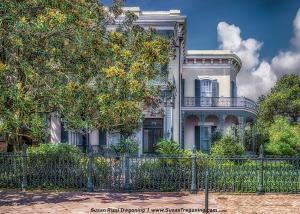
Following the Louisiana Purchase in 1803, Americans started to arrive in New Orleans and wanted a neighborhood to call their own. It took thirty years to happen but in 1826 when Jacques Livaudais failed to show up for divorce court preceding he lost ownership of the family plantation to his wife. In 1832, she moved home to France and sold the property to a group of businessmen that saw this land as American’s answer to the French and Creole dominated Vieux Carre. They parceled it off into a grid of 80 city blocks and it became part of the Village of Lafayette.
Wealthy Americans flocked to build mansions here. With plenty of space each mansion was surrounded by huge lawns and gardens some spanning full city blocks which earned the area its nickname the “Garden District”. That nickname stuck and the Garden District became its official name when the neighborhood was annexed into New Orleans in 1852.
While the lawns are no longer as grand as they once were, the mansions are still just as impressive as they were the day they were built. A visit to the Garden District offers a chance to see an entire neighborhood of preserved mansions from the 1800s and displays a melting pot of architectural styles that were “new” for the time period in which they were built.
The Garden District was recognized for its architectural and cultural significance in 1972, when it was listed on the National Register of Historic Places, and then again in 1974, when it was declared a National Historic Landmark. Most recently, the Garden District was designated as a Historic District in June 2007 by the Historic District Landmarks Commission.
Whether you choose to take a guided walking tour from one of the many local tour companies or just do it yourself, a visit to New Orleans is incomplete without a visit to the Garden District.
Please CLICK to continue reading